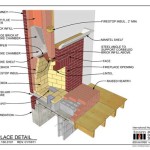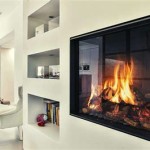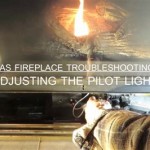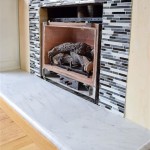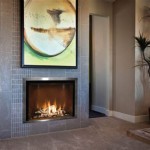Modern Double-Sided Fireplaces: A Contemporary Architectural Statement
Modern double-sided fireplaces have transcended their purely functional roots to become significant architectural elements, adding warmth, ambiance, and a distinct visual dynamic to contemporary homes. These fireplaces, also known as see-through or peninsula fireplaces, are designed to be viewed from two separate spaces, acting as both a heating source and a captivating focal point that connects and defines different areas within a home.
The appeal of double-sided fireplaces lies in their ability to serve multiple purposes. They can link a living room and dining room, a master bedroom and ensuite bathroom, or even seamlessly integrate indoor and outdoor living spaces. The transparent nature of the design allows for the warm glow and flickering flames to be enjoyed from multiple vantage points, creating a sense of shared comfort and visual continuity. Moreover, the architectural benefits are significant; they can visually expand smaller spaces, create a feeling of openness, and add a sophisticated touch to any interior design scheme.
The construction and installation of a modern double-sided fireplace require careful planning and adherence to safety regulations. Factors such as the type of fuel used (wood, gas, or electric), venting requirements, structural support, and local building codes must be considered early in the design process. Professional installation by qualified technicians is crucial to ensure safe and efficient operation.
Design Considerations: A Symbiotic Relationship Between Function and Aesthetics
The design of a double-sided fireplace necessitates a holistic approach, considering both its functional capabilities and its aesthetic contribution to the overall space. The chosen materials, dimensions, and style must complement the existing architecture and interior design. Furthermore, the placement of the fireplace should be carefully considered to maximize its visual impact and heating efficiency.
Material choices play a pivotal role in the overall aesthetic of the fireplace. Options range from traditional brick and stone to sleek stainless steel, glass, and concrete. Brick and stone provide a rustic, timeless appeal, while stainless steel and glass offer a more modern and minimalist aesthetic. Concrete, with its industrial chic vibe, can be molded into various shapes and finishes, providing a unique and contemporary look. The selection should be aligned with the overall décor of the rooms it will be affecting.
Dimensions are another critical consideration. A fireplace that is too large can overwhelm a small space, while one that is too small may be visually insignificant in a larger room. The proportions must be carefully calibrated to achieve a harmonious balance. Furthermore, the height of the firebox and the surrounding architectural elements can impact the viewing experience and the way the heat is distributed.
Style is also a key design driver. Double-sided fireplaces can be integrated into a variety of architectural styles, from traditional to contemporary. In classic settings, ornate mantels and decorative surrounds can be incorporated to enhance the fireplace's grandeur. In modern spaces, clean lines, minimalist detailing, and integrated storage solutions create a seamless and sophisticated look. The ultimate goal is to create a fireplace that not only provides warmth but also serves as a focal point that enhances the overall aesthetic appeal of the home.
Fuel Options: Wood, Gas, and Electric Alternatives
Modern double-sided fireplaces offer a range of fuel options, each with its own advantages and disadvantages. The choice of fuel will significantly impact the fireplace's performance, maintenance requirements, and environmental impact. Wood-burning fireplaces provide a traditional ambiance with the crackling sound and authentic aroma of burning wood. Gas fireplaces offer convenience and ease of use with instant ignition and adjustable flame settings. Electric fireplaces provide a clean and environmentally friendly alternative with no venting requirements.
Wood-burning fireplaces offer a quintessential fireplace experience. They provide a natural ambiance and a significant heat output. However, they require a dedicated source of firewood, regular cleaning of the firebox and chimney, and adherence to local regulations regarding wood burning. The environmental impact of wood-burning fireplaces is also a consideration, as they can contribute to air pollution. Modern wood-burning fireplaces often incorporate advanced combustion technologies to reduce emissions and improve efficiency.
Gas fireplaces offer a convenient and clean-burning alternative to wood. They can be fueled by natural gas or propane, providing instant ignition and adjustable flame settings. Gas fireplaces are also relatively low-maintenance, requiring only periodic inspection and cleaning. However, they do require a gas line connection and professional installation. The environmental impact of gas fireplaces is lower than that of wood-burning fireplaces, but they still contribute to greenhouse gas emissions.
Electric fireplaces are the most environmentally friendly option, producing no emissions and requiring no venting. They operate on electricity and use heating elements to generate warmth. Electric fireplaces offer a realistic flame effect that can be adjusted for brightness and color. They are also relatively easy to install, requiring only a standard electrical outlet. However, electric fireplaces typically provide less heat output than wood-burning or gas fireplaces. They are well-suited for smaller spaces or as supplemental heating sources.
Installation and Safety: Ensuring Proper Operation and Compliance
The installation of a double-sided fireplace is a complex process that requires careful planning and execution. It is crucial to engage qualified professionals who are experienced in fireplace installation and familiar with local building codes. The installation process involves several key steps, including site preparation, framing, venting, fuel line connection (if applicable), and finishing. Adherence to safety regulations is paramount to ensure the safe and efficient operation of the fireplace.
Site preparation involves assessing the structural integrity of the surrounding walls and floors, ensuring that they can support the weight of the fireplace. Framing is required to create a secure enclosure for the fireplace and to provide structural support for the surrounding architectural elements. Venting is essential for removing combustion gases from wood-burning and gas fireplaces. The venting system must be properly sized and installed to prevent carbon monoxide poisoning and other hazards. The type of venting required will depend on the type of fuel used and the local building codes.
Fuel line connection is required for gas fireplaces. A qualified gas fitter must connect the fireplace to the gas line and ensure that all connections are leak-proof. Electrical connections are required for both gas and electric fireplaces to power the ignition system, flame controls, and other features. Finishing involves installing the surrounding architectural elements, such as mantels, surrounds, and decorative panels. The finishing materials must be fire-resistant and installed in accordance with manufacturer's instructions.
Safety is the top priority during and after the installation process. Carbon monoxide detectors should be installed in the vicinity of the fireplace to provide early warning of carbon monoxide leaks. Regular inspection and maintenance are essential to ensure the continued safe operation of the fireplace. The chimney should be cleaned annually to remove creosote buildup, which can pose a fire hazard. The gas line should be inspected regularly for leaks. The firebox should be cleaned regularly to remove ash and debris.
Fireplace screens or doors are essential safety accessories, especially in homes with children or pets. They prevent sparks and embers from escaping the firebox and causing burns or fires. Glass doors also help to improve the efficiency of the fireplace by reducing airflow and retaining heat. Furthermore, ensuring proper ventilation around the fireplace prevents overheating and damage to surrounding materials.
By adhering to these design, fuel, and safety considerations, homeowners can enjoy the warmth, ambiance, and architectural beauty of a modern double-sided fireplace for years to come. The fireplace becomes a focal point, enhancing the value and enjoyment of the home.

Pros And Cons Of Double Sided Fireplace Modus Fireplaces

Double Sided Fireplaces Fireplace Modus

Flex 104db Bx2 Double Sided Fireplace Insert Ecosmart Fire

Double Sided Fireplaces Designer French Suspended Wood Heaters

Double Sided Fireplaces Fireplace Modus

13 Examples Of How To Include A Double Sided Fireplace Into Your Home

Double Sided Fireplace Design Ideas

Elevate Your Space With A Stunning Double Sided Fireplace

20 Gorgeous Two Sided Fireplaces For Your Spacious Homes

Mode Tall Gas Fireplace Double Sided For Stoke Est Living Design Directory
Related Posts

